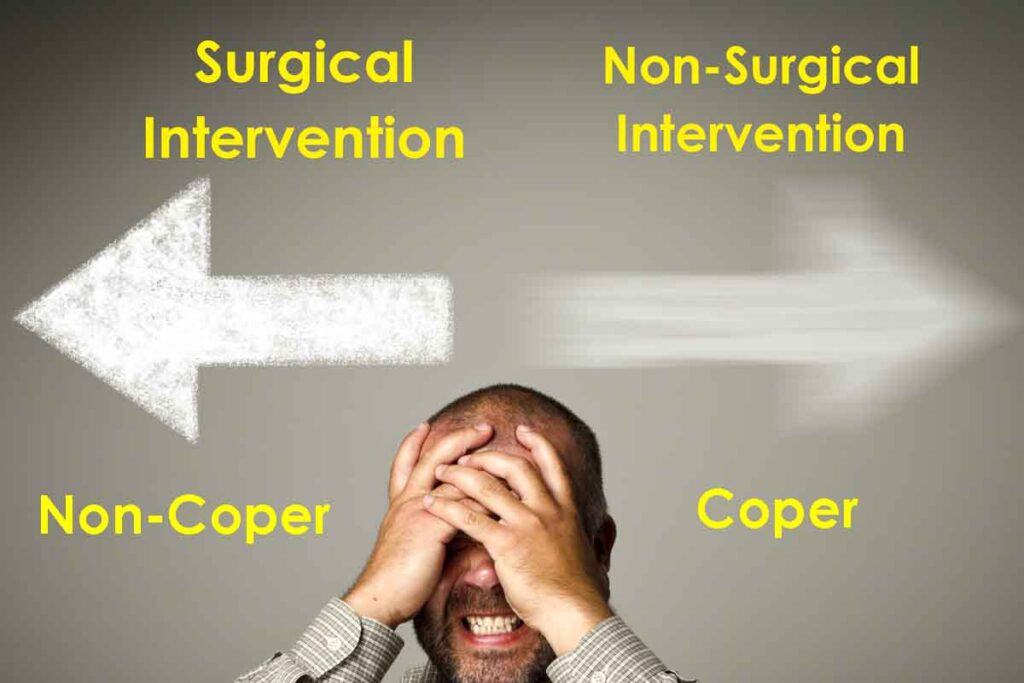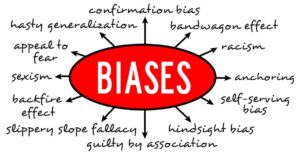Orthopedic surgery is not always necessary – coper vs non-coper

A diagnostic image such as an MRI can show significant structural damage such as a complete tear of the anterior cruciate ligament (ACL), a complete tear of the rotator cuff of the shoulder, a herniated spinal disc, or other musculoskeletal tissue damage.
In 1983 Frank Noyes and colleagues in a seminal study of patients without an intact ACL concluded that there are 3 subgroups. The subgroups are:
- Those that can function well during sports without an intact ACL.
- Those that can function well during normal activities of daily living without an intact ACL.
- Those who cannot function well during activities of daily living or sports without an intact ACL.
Significant orthopedic impairments can get better without surgery.
In 1999 M.E. Eastlack and colleagues coined the term “coper” and “non-copers”. Individuals with a complete tear of the ACL who compensate well for the injury are “copers” and those who require surgical intervention are “noncopers.”
The coping process for an orthopedic injury involves more than managing emotions and stress. It can involve lifestyle modifications, self-monitoring, learning self-management strategies, and strengthening adjacent joints/muscles.
Years prior to 1999 while I was in college playing soccer, I injured my knee suffering a complete tear of my ACL. For a while, I returned to playing soccer and did not have surgery to reconstruct my ACL. The next fall I switched from playing soccer to running cross country. As a young college student, I did not know it at the time I was an “ACL coper.” For decades successfully coped. I competed in marathons and ultramarathons without an ACL ligament.
Frank Noyes and colleagues described the “Rule of thirds” for ACL ligament insufficiency.
- 1/3rd gets better with rehabilitation – conservative non-surgical care.
- 1/3rd stays the same with rehabilitation – conservative non-surgical care.
- 1/3rd get worse with rehabilitation – conservative non-surgical care – failure.
Does the “rule of thirds” for ACL insufficiency apply to other musculoskeletal impairments?
John Kuhn and colleagues conducted a prospective trial following 452 individuals with symptomatic atraumatic full-thickness rotator cuff tears over a 10-year period. Patients underwent a standard non-operative physical therapy protocol (6 to 12 weeks). Twenty-seven percent failed non-operative treatment and underwent surgery. One-third were non-copers. Physical therapy was successful in more than 70%. This implies that the “rule of thirds” may also apply to complete rotator cuff tears.
Mario Lenza and colleagues in a prospective study of 544 patients with spinal conditions 60% of the patients were recommended unnecessary spinal surgery. This implies the “rule of thirds” may apply to degenerative spine conditions.
Can we predict who is going to be a coper or non-coper?
Research has not been able to answer this question.
We are left with an ambiguous decision process. When faced with ambiguity, recognition of biases is important.

What should we do?

Based on their retrospective observations, Noyes colleagues provide some general guidance.
- Initially, a non-surgical approach with activity modification & sufficient time (6 months or longer) to rehab the non-traumatic orthopedic injury adequately is the first step.
- Use surgery early if an individual is unwilling to alter their athletic lifestyle or if he/she has symptoms with routine activities of daily living.
Kuhn and colleagues found individuals with symptomatic full-thickness shoulder rotator cuff tears with low expectations regarding the effectiveness of Physical Therapy was found to predict early surgery – non-copers. If your bias is “Physical Therapy will not work, I need surgery,” it predicts you will be a “non-coper.”
If your confirmation bias or desirability bias is to avoid surgery and you want to be a coper then act to alter expectations.
Jeremy Lewis in the article An Open Letter to You, a unique individual living with shoulder pain provides a checklist of questions to ask surgeons and non-surgical health professionals, for people seeking care for shoulder pain. These questions apply to any orthopedic injury.
- What are the different management options available to me? This should include the option of not intervening & letting nature take its course.
- What are the expected outcomes for each option?
- What will happen to me, how long will it take, what will I have to do?
- What are the harms of each option?
Ask these questions of both a surgeon and a non-surgical health care professional, for a second opinion.
The airline industry provides a model for encouraging team members to speak up to prevent serious mistakes. If you decide to have surgery the Joint Commission provides guidance for patients to speak up. You the patient are a team member speak up. Ask questions. Take steps to get your healthcare provider more engaged in your plan of care.

Jeremey Lewis advises before electing to have shoulder surgery:
“Just be aware it might not fix your problem. Maybe only consider surgery when you have tried a minimum of 12 weeks of hard rehabilitation and after you have made every effort you can to improve your lifestyle. Finally if your physiotherapist is only offering you passive treatments or suggesting he/she can fix your problem, then I urge you to find another physiotherapist”.
Reflect on whether you want to be a coper or a non-coper.
The information on this website is not intended or implied to be a substitute for professional medical advice, diagnosis, or treatment. You are encouraged to perform additional research regarding any information contained available through this website with other sources and consult with your physician.
Damien Howell Physical Therapy – 804-647-9499 – Fax: 866-879-8591 At-Home, At Office, At Fitness Facility – I come to you, I do home visits Damien@damienhowellpt.com
